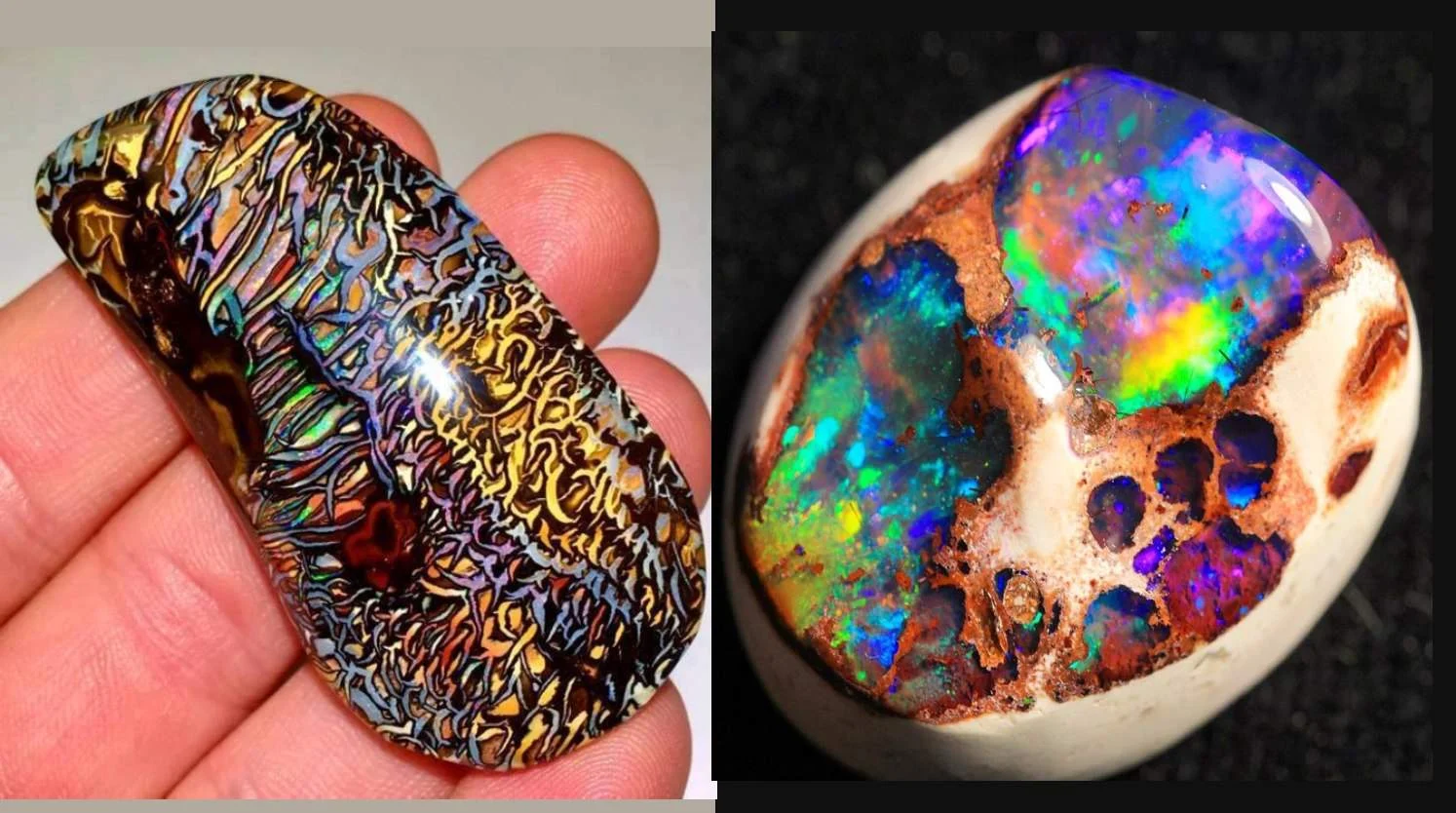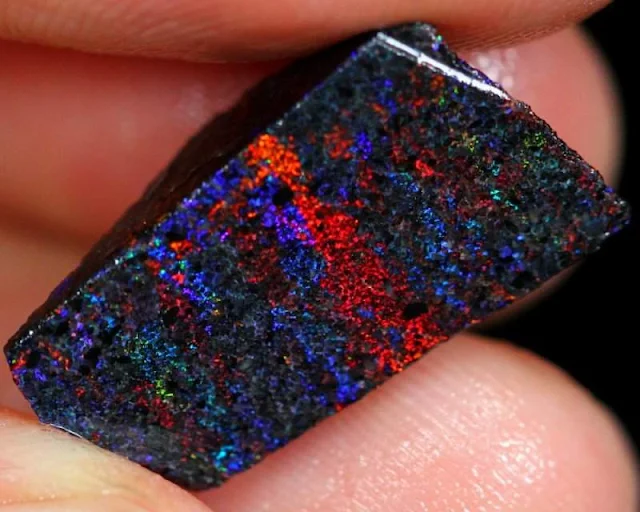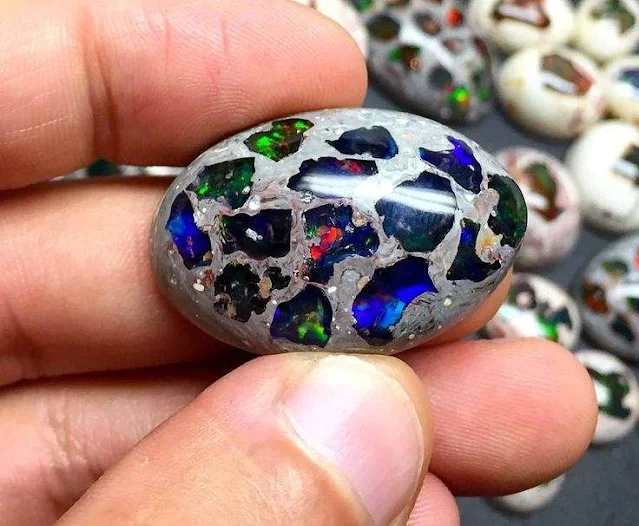Types of Matrix Opal
Matrix opal is a captivating variety of opal distinguished by its unique appearance. Unlike the smooth, polished opals we often see in jewelry, matrix opal features precious opal embedded within a contrasting host rock, often ironstone or sandstone. This creates a dramatic visual effect, with flashes of fiery color peeking through a dark, earthy matrix.
Matrix Opal Formation
Matrix opal formed Millions of years ago, silica-rich fluids seeped into cracks and voids within these host rocks. As these fluids solidified, they transformed into the mesmerizing opal we see today. The surrounding ironstone or sandstone, acting as a protective embrace, preserved the opal's vibrant play-of-color. This contrast between the dark earthy matrix and the flashes of fiery hues within is what defines the captivating beauty of matrix opal, a testament to the Earth's artistic hand in shaping its treasures.
 |
| Matrix Opal left from Australia. Right from Mexico |
Matrix Opal Appearance and Rarity
The host rock, typically ironstone or sandstone, is usually dark grey, black, or brown, providing a stark contrast to the vibrant play-of-color within the precious opal inclusions. These inclusions can be in various shapes and sizes, adding to the stone's natural beauty.
Rarity and value: Matrix opal is considered a relatively rare gemstone compared to other opal varieties like common opal or boulder opal.
Where to Find Matrix opals
Matrix Opal can be found in various locations around the world, including Australia, Mexico, and Ethiopia, each boasting its own unique type and characteristics.
- Australia: Koroit (king of matrix opals!), Andamooka (potch opal magic), Lightning Ridge (fiery explosions in black rock).
- Mexico: Cantera ("fire opal" glows against volcanic darkness).
- Ethiopia: Welo's mystical greens & blues.
Types of Matrix Opal
Koroit Matrix Opal
 |
| Koroit Matrix Opal. Photo ©️ Flashfire-Opals |
Imagine a swirling kaleidoscope of blues, greens, and fiery reds trapped within a dark ironstone canvas. That's Koroit matrix opal, found in the mineral-rich fields of South West Queensland, Australia. This precious variety is renowned for its vivid play-of-color, often displaying a signature "pinfire" pattern – tiny, sparkling specks of light dancing across the opal. Its formation involves silica-rich fluids filling cracks and voids in the ironstone over millions of years, creating a mesmerizing contrast between the earthy matrix and the vibrant opal inclusions.
Value: Koroit matrix opal is highly sought-after due to its rarity, beauty, and large opal patches. It is prized by collectors and jewelry makers alike.
Andamooka Matrix Opal
 |
| Matrix Andamooka Opal Rough from Andamooka, Australia |
Hailing from the arid plains of South Australia, Andamooka matrix opal exudes a distinct earthy charm. Its host rock, often a porous limestone, is typically lighter in color compared to Koroit's, ranging from beige to brown. The opal inclusions, although less fiery than their Koroit counterparts, often display a soft, milky play-of-color, reminiscent of moonlight shimmering on a desert landscape. Interestingly, Andamooka matrix opal can be "smoky," meaning its potential play-of-color might not be immediately visible.
Value: Andamooka matrix opal is more affordable than Koroit due to its smaller opal patches, but its unique beauty and potch opal presence make it a popular choice for jewelry and collectors.
Boulder Matrix Opal
 |
| Boulder Matrix Opal (Queensland Ironstone) |
Boulder Matrix Opal (Queensland Ironstone)
Origin: Found in the Queensland region of Australia, this type is not technically a matrix opal, but shares some similarities. It features precious opal within a host rock, but the opal is typically concentrated in veins or pockets, rather than being evenly distributed.
Characteristics: Queensland boulder matrix opal can have a variety of host rock colors, including ironstone, sandstone, and even clay. The opal inclusions can be any color, but often display a rich blue, green, and red play-of-color.
Value: Queensland boulder matrix opal can be quite valuable depending on the size and quality of the opal inclusions. It's a popular choice for jewelry and collectors who appreciate its unique boulder formation and vibrant play-of-color.
Cantera Matrix Opal
 |
| Cantera matrix opal. Photo © Craig Gower |
Across the globe, in the volcanic regions of Mexico, lies Cantera matrix opal. This variety boasts a unique character, often featuring a matrix of red, yellow, or orange jasper, contrasting beautifully with the opal inclusions. The opal itself can display a range of colors, including blue, green, and even a rare lavender hue. Cantera opal's formation is linked to volcanic activity, where silica-rich fluids interacted with the volcanic rocks, creating a mesmerizing blend of fire and earth.
Value: Cantera matrix opal is a relatively affordable option compared to other types, making it a popular choice for jewelry and collectors who appreciate its unique fiery opal inclusions.
Conclusion
Matrix Opal, with its captivating play-of-color set against the backdrop of host rocks, represents a harmonious blend of nature's artistry. From the opal fields to jewelry collections worldwide, Matrix Opal continues to enchant gemstone enthusiasts with its unique charm. Whether admired in its natural state or transformed into wearable works of art, Matrix Opal stands as a testament to the beauty that emerges when geological forces and artistic craftsmanship converge.
Read also:
How Do Opalised Fossils Form?
Types of Opal With Photos
Boulder Pipe Opal

%20(1).webp)






